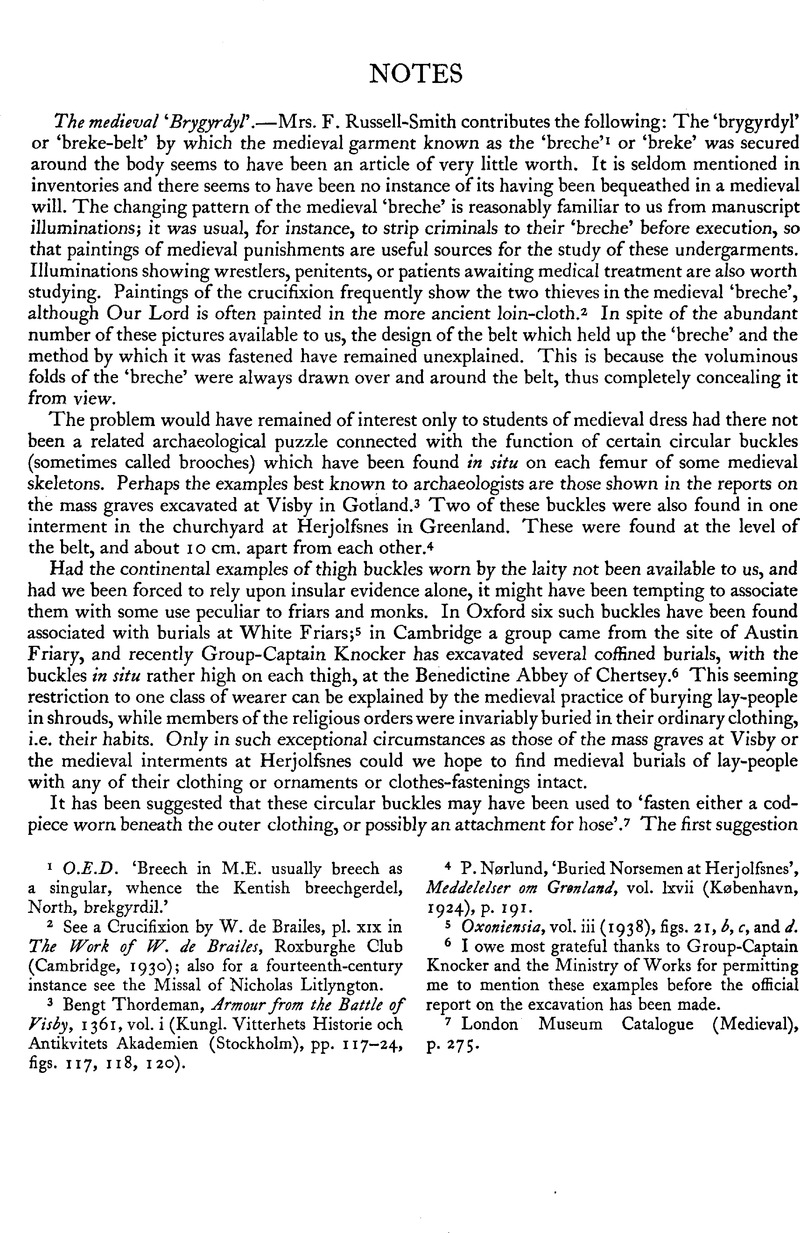Article contents
The medieval ‘Brygyrdl’
Published online by Cambridge University Press: 29 November 2011
Abstract

- Type
- Notes
- Information
- Copyright
- Copyright © The Society of Antiquaries of London 1956
References
page 218 note 1 O.E.D. ‘Breech in M.E. usually breech as a singular, whence the Kentish breechgerdel, North, brekgyrdil.’
page 218 note 2 See a Crucifixion by W. de Brailes, pl. XIX in The Work of W. de Brailes, Roxburghe Club (Cambridge, 1930); also for a sourteenth-century instance see the Missal of Nicholas Litlyngton.Google Scholar
page 218 note 3 Thordeman, Bengt, Armour from the Battle of Visby, 1361, vol. i (Kungl. Vitterhets Historie och Antikvitets Akademien (Stockholm), pp. 117–24, figs. 117, 118, 120).Google Scholar
page 218 note 4 Nørlund, P., ‘Buried Norsemen at Herjolfsnes’, Meddelelser om Grønland, vol. lxvii (København, 1924), p. 191.Google Scholar
page 218 note 5 Oxoniensia, vol. iii (1938), figs. 21, b, c, and d.
page 218 note 6 I owe most grateful thanks of Group-Captain Knocker and the Ministry of Works for permitting me a mention these examples before the official report on the excavation has been made.
page 218 note 7 London Museum catalogue (Medieval), p. 275.
page 219 note 1 Oxoniensia, vol. III (1938), p. 174.Google Scholar
page 219 note 2 The Luttrell Psalter, B.M. MS. Add. 42130, fol. 60.
page 219 note 3 It was, however, customary for manual labourers to release the hose from their fastenings while at work, and in the fourteenth century to allow them to fall over the garter (Holkham Bible Picture Book, fol. 5r.) or in the fifteenth century to allow them to fall with their points dangling.
page 219 note 4 See Nørlund, P., op. cit., Meddelelser om Grenland (København, 1924), pp. 183 et seq.Google Scholar
page 219 note 5 Many of the Visby buckles also had fragments of leather and even of thongs adhering to them. See Thordeman's publication mentioned above, figs. 120, 19–22.
page 219 note 6 The miniature size of both buckle and belt make it seem likely that if this was a ‘brygyrdyl’ it was made for a small child.
page 220 note 1 See Chaucer's translation of the Romance of the Rose, A fragment, 95–105.
page 220 note 2 Oxford. Bodleian MS. Douce 366, fol. 109.
page 221 note 1 Gómez-Moreno, Manuel, El Panteón Real de las Huelgas de Burgos (Madrid, 1946), pp. 22 and 25, pl. XXX, a and b.Google Scholar
page 221 note 2 Chronica de Johannis de Reading, ed. James, Tait (Manchester, 1914), Hist. Ser. vol. XX, p. 167: ‘… insuper Paltoks, vestibus curtissimis lanis ac aliis tenuis obturatis ac consutis per totum, quae anos suos sive verenda celare nequiverunt, caligis etiam tibiis longioribus ad curta vestimenta colligulatis ligulis quas harlotes, gadelinges et lorels vocabant.’Google Scholar
- 1
- Cited by


